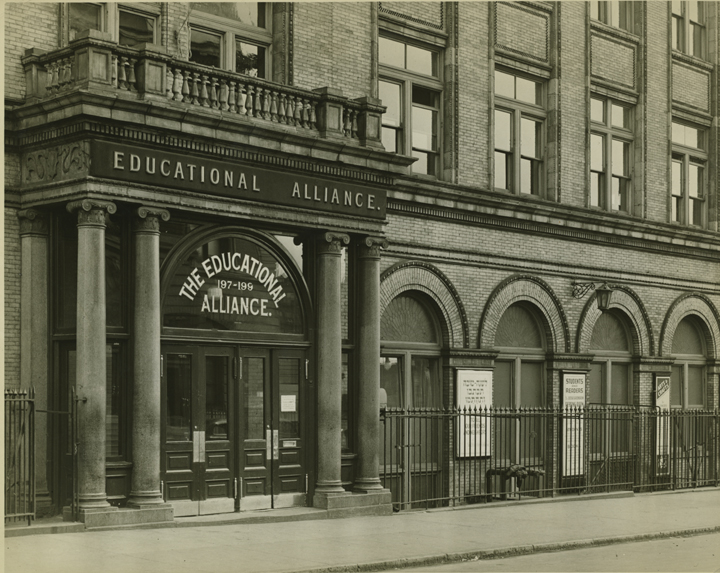HERE
Overview:
-The Settlement House movement was a Progressive Era attempt at reforming the issues plaguing urban dwellers, particularly immigrants residing in tenements. Jewish immigrants were marginalized and struggled hopelessly against poverty, a cruel struggle that required working long hours for low wages. The kindness of individuals alone could not change the lifestyles of recent immigrants completely, but such altruism was met with warm gratitude. A number of selfless individuals were spurred into action by the often overcrowded, squalid, and disease ridden living conditions that were the harsh reality for Jewish immigrants living in the Lower East Side. Settlement house founders realized that there was work to be done and no one else was taking the initiative.

Photo Credit: YIVO Insitute
Important Figures:

-Stanton Coit began the Settlement House movement in New York City by founding the University Settlement on the Lower East Side in 1886. The Settlement House movement corresponded to the influx of Jewish immigrants, and was a means of dealing with overcrowding, disease, and issues of assimilation to American culture. Coit’s settlement house became and model and inspiration for the ones that followed.
Photo Credit: Humanist Heritage
 -Nurse Lillian Wald worked with fellow nurse Mary Brewester to provide help to anyone in need at little to no cost. Seeing that no one else had taken the initiative to assist the people living at the bottom of the barrel, Wald felt a responsibility to take action. Nobody who needed assistance was denied it, and payments were based on an honor system. They provided medical treatment to people suffering from measles, typhoid fever and vermin bites, which attested to the unsanitary conditions in many tenements. The Backyard of the Henry Street settlement was converted into a playground. What makes Wald’s philanthropy especially intriguing was the fact that she was a German Jew helping predominantly Russian Jewish immigrants. Reconciliation between the Germans and Eastern Europeans was rare at this time.
-Nurse Lillian Wald worked with fellow nurse Mary Brewester to provide help to anyone in need at little to no cost. Seeing that no one else had taken the initiative to assist the people living at the bottom of the barrel, Wald felt a responsibility to take action. Nobody who needed assistance was denied it, and payments were based on an honor system. They provided medical treatment to people suffering from measles, typhoid fever and vermin bites, which attested to the unsanitary conditions in many tenements. The Backyard of the Henry Street settlement was converted into a playground. What makes Wald’s philanthropy especially intriguing was the fact that she was a German Jew helping predominantly Russian Jewish immigrants. Reconciliation between the Germans and Eastern Europeans was rare at this time.Photo Credit: Henrystreet.org
Settlement Houses Provided:
-Nursing for illnesses and injuries. The nurses accompanied patients to the hospital when treatments were beyond their realm of knowledge.
-Parents were often too busy working to look after their children after school, and settlement houses offered recreational activities for young children as well as kindergarten educations.
-Summer Camps and Music Classes.
-The Educational Alliance, founded in 1889, addressed the grievances of tenement dwellers on the Lower East Side. English and American History courses were also taught.
-Encouraged assimilation by teaching English courses.
-Protests were organized against harsh working conditions.
-Relied upon organizations and wealthy individuals for support.
THERE
Landsmanschaftn:
-Groups from the same part of Eastern Europe felt a sense of camaraderie amidst the strange new culture and language they were exposed to in the United States. The goal of these organizations was comparable to that of Settlement Houses: to help recent immigrants adjust to their new homes. These groups were a means of resisting assimilation.
-Provided: medical benefits, interest-free loans, aid to their hometowns in Europe, and funereal assistance.
-There were over 530 landmanschaftn in 1914. The sharp increase in the number of these organizations was directly related to World War I, which created urgent need for aid back home overseas.
-Declined in the middle of the twentieth century, most likely as a result of the dreadful Holocaust.
-Preserved Jewish culture, as opposed to settlement houses which were designed to Americanize immigrants.
Shtetls:
-Shtetls were the overseas equivalents of landsmanschaftn. Through these extended networks, Jews traded and shared resources with one another. These communities provided moral support during a time when anti-Semitism was prevalent across Eastern Europe.
-Different shtetls communicated with one another, and larger shtetls shared resources with smaller ones. This culminated in a strong sense of Jewish kinship and community.
-Whereas the goal of landmanschaftn was to preserve Jewish culture in the face of Americanized youth, the shtetls were a support system for all Jews in the face of discrimination. We can look to the Torah as the origin for this generosity. Tzedakah is a form of selfless, genuine charity that is expected of all Jews. It was not only normal, but expected, that wealth be spread throughout the community.

